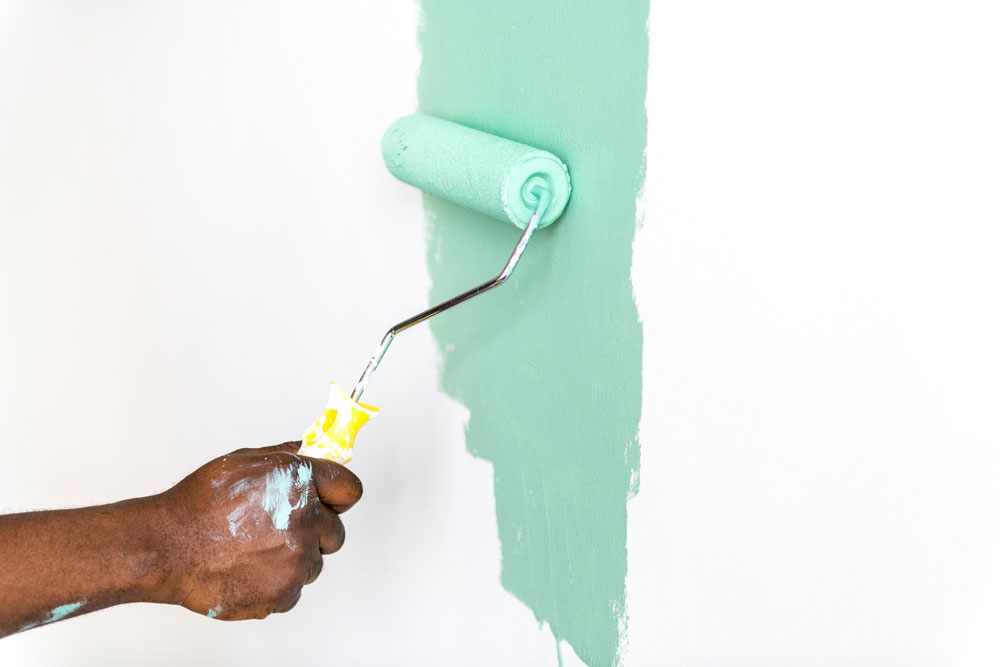The first step in calculating the amount of paint required is to calculate the surface area or for epoxy floor coating to be painted. This area may be the wall, or the ceiling, or the door of the room.
Calculating the square footage of wall work is relatively easy and the only hard part is that you have to be very careful and do not miss any surface. You need a meter, pencil and notebook to calculate the color area of the building.
Try to draw a general picture of the room map in the notebook. You can map each room separately. Mark the location of windows and doors completely on the image. Then measure the width and height of each wall in feet and write on the map.
Then measure the length and width of all the doors and windows (and any other parts that should not be painted) and note these measurements as well. Finally, you need to subtract the area of these parts from the total area of the wall, because these parts either do not paint or need a different color.
For example, doors are painted with special wood and primer paint, the glass parts of the windows are not painted naturally, and the color of the window frames is different from the color of the walls. In this section, it is better to note the material of metal and wooden items on the picture and specify so that you do not get confused when buying different types of paints.
Learn More About Acrylic Vs. Latex Paint
We provide a wide variety of epoxy floor coatings
Now we come to the part where we talk about the middle ground. To do this, you must first calculate the total area of the parts to be painted. So write down the numbers on the map on a separate page and calculate the area of the ceiling and walls as shown below. Then calculate the area of non-painting surfaces such as windows and subtract from the previous number.
Divide the final number by 8.5. The number 8.5 is the surface value that each liter can of paint covers. Dividing the total area by this number, the number of liters of paint required for the walls is obtained. You can also render the result to make your purchase easier.
Ceiling paint estimator
Use the following formula to estimate the amount of ceiling paint you need. Double the result if the ceiling requires two coats.
- Multiply the length of the ceiling times its width to find its area.
13 × 19 = 247 square feet - Divide that number by 350 (the estimated square feet covered per gallon) to figure out how many gallons of paint you need.
280 ÷ 350 = 0.7
For this example, you want to buy 1 gallon of ceiling paint for a single coat.
Wall paint estimator
Use the following formula to estimate the amount of wall paint you need. Double the result if the walls require two coats.
- Add together the length of each wall.
13 + 19 + 13 + 19 = 64 feet - Multiply the sum by the wall height, to find the total wall area.
64 × 8 = 512 square feet - Subtract 20 square feet for each door (20 × 2 = 40) and 15 square feet for each window (15 × 2 = 30) to find the actual amount of wall area you’re painting.
512 – 70 = 442 square feet - Divide this figure by the paint coverage (350 square feet per gallon), and the result is the number of gallons to purchase.
442 ÷ 350 = 1.27
For this example, you want to buy 1 gallon and 2 quarts of paint for a single coat.
Learn What is Anti-Rust Paint

Epoxy floor coatings
Woodwork paint estimator
Measure the length of the trim in feet, and multiply that number by 1/2 foot (.5), as a rough size for the width of the trim. Include all the trim around doors and windows, at baseboards, along with the ceiling, and for any built-in furniture.
As an example, imagine that you have ceiling molding running around a room that is 14 feet wide and 20 feet long.
- Determine the total length of molding around the room by adding together the length of all the walls that the molding covers.
Round the numbers off to the nearest foot.
13 + 19 + 13 + 19 = 64 feet - Multiply the sum by 0.5 for an estimated width of the molding.
64 × 0.5 = 32 square feet - Divide this number by 350 to estimate the gallons of paint required to cover the molding.
32 ÷ 350 = 0.09
The result in this example is much less than a quart, but you may paint other woodwork in the room the same color, so buying a full quart may not be terribly wasteful.
Do You Know What is Paint Primer?
Door and window estimator
Use the same figure for estimating door coverage as you use in your wall-area calculations — 20 square feet = one door. Multiply the number of doors by 20, doubling the answer if you plan to paint both sides. Wall paint estimates allow for 15 square feet for each window. Use about half that window area to figure trim and inside sash — the glass isn’t important to the calculation.
For the room in this example:
- Multiply the number of doors by 20.
2 × 20 = 40 square feet - Multiply the number of windows by 7.5.
2 Windows × 7.5 = 15 square feet - Add these numbers together.
40 + 15 = 55 - Divide the result by 350 (the estimated square feet covered per gallon).
55 ÷ 350 = 0.16
Often, you end up needing to buy only a quart of paint, which goes a long way on doors and window trim.
A Few Important Points
- Do not forget to calculate the square footage of walls, radiators, pipes, door and window frames, and window railings according to your needs.
- Do not forget that you will need plain paint or vinyl (which is washable) to paint the plaster walls and ceiling. But wooden and metal surfaces must be painted with oil paint and special.
- In calculating the color area of the building for the walls and ceiling, calculate 2 layers of coats, because these areas usually require more than one coat of paint. You do not usually need a primer or primer to calculate the color of the building. Unless you are painting on wood or metal.
- In addition to your own numbers, pay attention to the descriptions on the color packaging. Usually, paint companies describe on paint cans how much of that paint covers what surface. Multiply the final amount according to your needs.
- Professionals usually add 10% to the final number in the calculation of the building painting area so that they can adjust the paint concentration to their liking without any worries.
- A common way to calculate the square footage of a wall is to multiply the unit area by 3. For example, for a 70-feet unit, they produce 210 square feet of paint. But we suggest that as much as possible to calculate the square foot of the wall, follow the method of calculating the painted area of the building mentioned in this article because it will have much less error. However, the approximate method may have many errors due to various factors such as the number of bedrooms, the number of cupboards, and so on.
- In general, one liter of paint can be expected to cover about 8.5 square feet. If the walls are not painted with Knauf, you need a little more than a liter of paint, because this material absorbs more paint.

